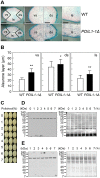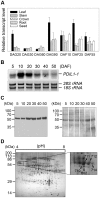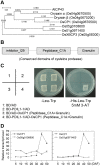Protein disulfide isomerase-like protein 1-1 controls endosperm development through regulation of the amount and composition of seed proteins in rice
- PMID: 22970232
- PMCID: PMC3435311
- DOI: 10.1371/journal.pone.0044493
Protein disulfide isomerase-like protein 1-1 controls endosperm development through regulation of the amount and composition of seed proteins in rice
Abstract
Protein disulfide isomerase (PDI) is a chaperone protein involved in oxidative protein folding by acting as a catalyst and assisting folding in the endoplasmic reticulum (ER). A genome database search showed that rice contains 19 PDI-like genes. However, their functions are not clearly identified. This paper shows possible functions of rice PDI-like protein 1-1 (PDIL1-1) during seed development. Seeds of the T-DNA insertion PDIL1-1 mutant, PDIL1-1Δ, identified by genomic DNA PCR and western blot analysis, display a chalky phenotype and a thick aleurone layer. Protein content per seed was significantly lower and free sugar content higher in PDIL1-1Δ mutant seeds than in the wild type. Proteomic analysis of PDIL1-1Δ mutant seeds showed that PDIL1-1 is post-translationally regulated, and its loss causes accumulation of many types of seed proteins including glucose/starch metabolism- and ROS (reactive oxygen species) scavenging-related proteins. In addition, PDIL1-1 strongly interacts with the cysteine protease OsCP1. Our data indicate that the opaque phenotype of PDIL1-1Δ mutant seeds results from production of irregular starch granules and protein body through loss of regulatory activity for various proteins involved in the synthesis of seed components.
Conflict of interest statement
Figures






Similar articles
-
The failure to express a protein disulphide isomerase-like protein results in a floury endosperm and an endoplasmic reticulum stress response in rice.J Exp Bot. 2012 Jan;63(1):121-30. doi: 10.1093/jxb/err262. Epub 2011 Oct 6. J Exp Bot. 2012. PMID: 21984651 Free PMC article.
-
Distinct roles of protein disulfide isomerase and P5 sulfhydryl oxidoreductases in multiple pathways for oxidation of structurally diverse storage proteins in rice.Plant Cell. 2011 Jan;23(1):210-23. doi: 10.1105/tpc.110.079509. Epub 2011 Jan 28. Plant Cell. 2011. PMID: 21278127 Free PMC article.
-
Protein disulfide isomerase like 1-1 participates in the maturation of proglutelin within the endoplasmic reticulum in rice endosperm.Plant Cell Physiol. 2010 Sep;51(9):1581-93. doi: 10.1093/pcp/pcq098. Epub 2010 Jul 13. Plant Cell Physiol. 2010. PMID: 20627947
-
Overexpression of BiP has inhibitory effects on the accumulation of seed storage proteins in endosperm cells of rice.Plant Cell Physiol. 2009 Aug;50(8):1532-43. doi: 10.1093/pcp/pcp098. Epub 2009 Jun 29. Plant Cell Physiol. 2009. PMID: 19567376
-
The rice mutant esp2 greatly accumulates the glutelin precursor and deletes the protein disulfide isomerase.Plant Physiol. 2002 Apr;128(4):1212-22. doi: 10.1104/pp.010624. Plant Physiol. 2002. PMID: 11950970 Free PMC article.
Cited by
-
Laser Microdissection-Based Tissue-Specific Transcriptome Analysis Reveals a Novel Regulatory Network of Genes Involved in Heat-Induced Grain Chalk in Rice Endosperm.Plant Cell Physiol. 2019 Mar 1;60(3):626-642. doi: 10.1093/pcp/pcy233. Plant Cell Physiol. 2019. PMID: 30517758 Free PMC article.
-
Genetic Background Negates Improvements in Rice Flour Characteristics and Food Processing Properties Caused by a Mutant Allele of the PDIL1-1 Seed Storage Protein Gene.Rice (N Y). 2022 Mar 5;15(1):13. doi: 10.1186/s12284-022-00560-w. Rice (N Y). 2022. PMID: 35247122 Free PMC article.
-
CRISPR/Cas9 and Transgene Verification of Gene Involvement in Unfolded Protein Response and Recombinant Protein Production in Barley Grain.Front Plant Sci. 2021 Nov 15;12:755788. doi: 10.3389/fpls.2021.755788. eCollection 2021. Front Plant Sci. 2021. PMID: 34868146 Free PMC article.
-
Proteomic analysis of symbiotic proteins of Glomus mosseae and Amorpha fruticosa.Sci Rep. 2015 Dec 10;5:18031. doi: 10.1038/srep18031. Sci Rep. 2015. PMID: 26658758 Free PMC article.
-
Metabolic Regulation of Carotenoid-Enriched Golden Rice Line.Front Plant Sci. 2016 Oct 28;7:1622. doi: 10.3389/fpls.2016.01622. eCollection 2016. Front Plant Sci. 2016. PMID: 27840631 Free PMC article.
References
-
- Tsai C, Larkins B, Glover D (1978) Interaction of the opaque-2 gene with starch-forming mutant genes on the synthesis of zein in maize endosperm. Biochem Genet 16: 883–896. - PubMed
-
- Miles MJ, Morris VJ, Orford PD, Ring SG (1985) The roles of amylose and amylopectin in the gelation and retrogradation of starch. Carbohydr Res 135: 271–281.
-
- Gallant DJ, Bouchet B, Baldwin PM (1997) Microscopy of starch: evidence of a new level of granule organization. Carbohydr Polym 32: 177–191.
-
- Thompson DB (2000) On the non-random nature of amylopectin branching. Carbohydr. Polym 43: 223–239.
-
- Smith AM, Denyer K, Martin C (1997) The synthesis of the starch granule. Ann Rev Plant Biol 48: 67–87. - PubMed
Publication types
MeSH terms
Substances
LinkOut - more resources
Full Text Sources
Molecular Biology Databases
Research Materials

